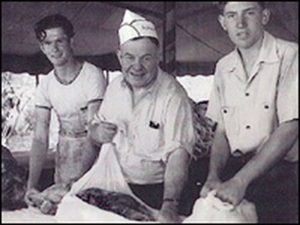Several lifetimes ago, in the late 1930s, the Federal Writers’ Project commissioned hundreds of unemployed and presumably hungry writers across the country to chronicle what their neighbors put on their table, hoping to compile a book called America Eats. World War II, however, intervened and nothing came of its efforts except heaps of notes which, for years, lay untouched and fallow in the archives of the Library of Congress.

Eating their way through picnics, fish fries and church suppers, the writers not only filled their stomachs, they also seemed to have had a good time. “Nostalgia flowed copiously through these reports and the happy talk rarely let up. Every fish fry and Masonic lodge supper glowed with love and good cheer,” observed Laura Shapiro, as she took the measure of this early foray into American food writing.
Having had the pleasure of working with some of this material at the New York City Municipal Archives where, many cartons later, it bore the title,“Feeding the City,” I know just what Shapiro means. There’s something free, unfettered and even innocent about the New York writers’ observations. One of their number, pitching an idea for a section on Jewish food, put it this way: “This chapter offers a chance to talk about food here with the same reverence, enthusiasm and gusto that a Jewish Escoffier, Savarin or George Rector might write about the sort of food about which Jewish people are most fond. It isn’t all garlic!”
I dwell on the history of “America Eats” because I think we’re long overdue for a contemporary version, one that would pay heed to the profound culinary changes that have occurred in the United States since the 1940s. Food manufacturers, as the New York Times observed recently on the first page of its business section, now make a point of catering to the varied palates of a steadily increasing ethnic market. At the same time, a substantial number of ethnic products, from dulce de leche to lemon grass, have gone ‘mainstream,’ much like the bagel and dim sum of a previous immigrant generation.
America eats differently these days. I hope there’s a 21st century Escoffier, Savarin or Rector taking note.

